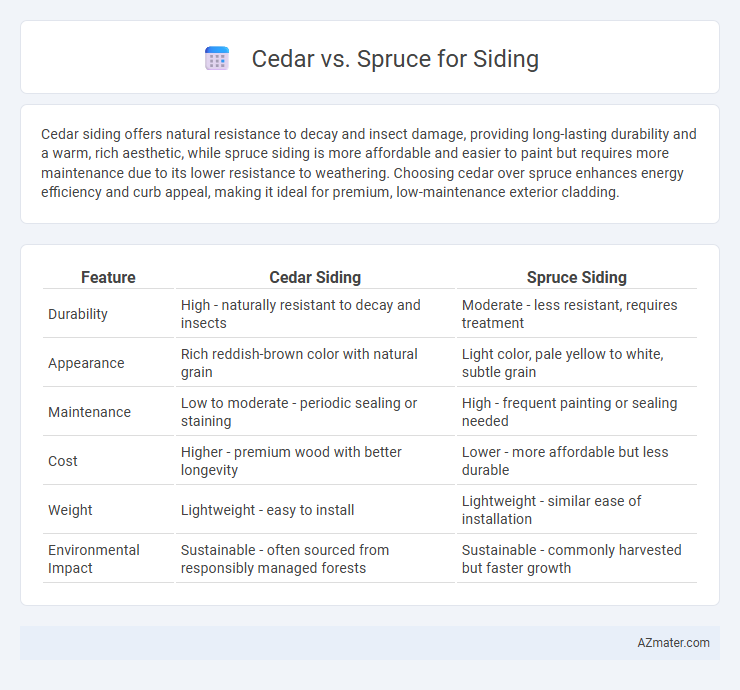Cedar siding offers natural resistance to decay and insect damage, providing long-lasting durability and a warm, rich aesthetic, while spruce siding is more affordable and easier to paint but requires more maintenance due to its lower resistance to weathering. Choosing cedar over spruce enhances energy efficiency and curb appeal, making it ideal for premium, low-maintenance exterior cladding.
Table of Comparison
| Feature | Cedar Siding | Spruce Siding |
|---|---|---|
| Durability | High - naturally resistant to decay and insects | Moderate - less resistant, requires treatment |
| Appearance | Rich reddish-brown color with natural grain | Light color, pale yellow to white, subtle grain |
| Maintenance | Low to moderate - periodic sealing or staining | High - frequent painting or sealing needed |
| Cost | Higher - premium wood with better longevity | Lower - more affordable but less durable |
| Weight | Lightweight - easy to install | Lightweight - similar ease of installation |
| Environmental Impact | Sustainable - often sourced from responsibly managed forests | Sustainable - commonly harvested but faster growth |
Introduction to Cedar and Spruce Siding
Cedar siding offers natural resistance to moisture, decay, and insects, making it a durable choice for exterior cladding, while its rich grain and warm hues enhance curb appeal. Spruce siding, known for its affordability and lighter color palette, provides a smooth surface ideal for painting or staining to match various architectural styles. Both wood types have distinct properties that influence durability, maintenance, and aesthetic, important factors in selecting siding materials.
Wood Characteristics: Cedar vs. Spruce
Cedar siding is prized for its natural resistance to moisture, decay, and insect damage, thanks to its high levels of natural oils and tannins, making it highly durable in varying climates. Spruce, while lighter and more affordable, lacks the same level of natural protection and tends to absorb moisture more readily, increasing susceptibility to rot and insect infestation unless properly treated. The fine, straight grain of spruce provides a smooth surface ideal for painting, whereas cedar's textured grain offers a distinctive, rustic appearance that can weather gracefully over time.
Durability and Longevity Comparison
Cedar siding offers superior durability due to its natural resistance to rot, decay, and insect damage, making it ideal for long-term exterior applications. Spruce siding, while more affordable, lacks the same level of natural preservative oils and typically requires additional treatments to enhance its lifespan. Cedar's longevity can exceed 30 years with proper maintenance, whereas untreated spruce siding often lasts less than 15 years in similar environmental conditions.
Maintenance Requirements
Cedar siding requires regular maintenance, including annual sealing or staining to protect against moisture and UV damage, which helps preserve its natural durability and aesthetic appeal. Spruce siding demands more frequent upkeep due to its softer wood grain, often needing paint or stain reapplication every 2-3 years to prevent rot, insect infestation, and weathering. Both woods benefit from periodic inspections and prompt repairs to extend their lifespan, but cedar generally offers a lower-maintenance option for siding applications.
Weather Resistance and Climate Suitability
Cedar siding offers superior weather resistance due to its natural oils and tight grain, making it ideal for humid and rainy climates where moisture durability is crucial. Spruce, while more affordable, has a softer wood structure that absorbs moisture more readily, leading to potential warping or decay in damp environments. For harsh weather conditions, cedar's resilience to rot, insects, and temperature extremes ensures long-lasting performance and reduced maintenance costs.
Aesthetic Differences and Finish Options
Cedar siding offers rich, warm tones with natural variations in color that age to a soft, silver-gray patina, making it ideal for a rustic or traditional aesthetic. Spruce siding features a lighter, more uniform appearance with subtle grain patterns, providing a clean and contemporary look. Cedar accepts stains and paints more readily for diverse finish options, while spruce often requires a primer and paint to enhance durability and color retention.
Environmental Impact and Sustainability
Cedar siding is highly valued for its natural rot resistance and low maintenance needs, contributing to longer lifespan and reduced environmental waste. Spruce, while less durable, often comes from faster-growing species, which can make it a more renewable resource if sourced from sustainably managed forests. Both woods offer carbon sequestration benefits, but choosing FSC-certified cedar or spruce ensures responsible forestry practices and minimal ecological footprint.
Cost Analysis: Cedar vs. Spruce Siding
Cedar siding typically costs between $5 to $9 per square foot, reflecting its natural resistance to rot and insects, which reduces long-term maintenance expenses. Spruce siding, priced around $3 to $6 per square foot, offers a more budget-friendly option but may require more frequent treatments and upkeep due to its lower durability. Choosing cedar often leads to higher initial investment but can result in better long-term value through enhanced longevity and lower repair needs.
Installation Process and Considerations
Cedar siding is favored for its natural resistance to rot and insects, requiring careful sealing during installation to maintain durability and prevent moisture penetration. Spruce siding is generally more affordable and lightweight, but it demands thorough priming and painting to protect against weather and decay. Both materials necessitate proper ventilation and moisture barriers during installation to enhance longevity and performance.
Best Uses and Applications for Each Material
Cedar siding is prized for its natural resistance to decay and insect damage, making it ideal for high-moisture environments and exterior walls where durability and a classic aesthetic are desired. Spruce siding offers a lighter, more affordable option with good strength and stability, often used in regions with moderate climates or for painted finishes that require a smooth surface. Both materials excel in residential applications, but cedar's superior weather-resistant properties make it better suited for long-term outdoor exposure.

Infographic: Cedar vs Spruce for Siding
 azmater.com
azmater.com